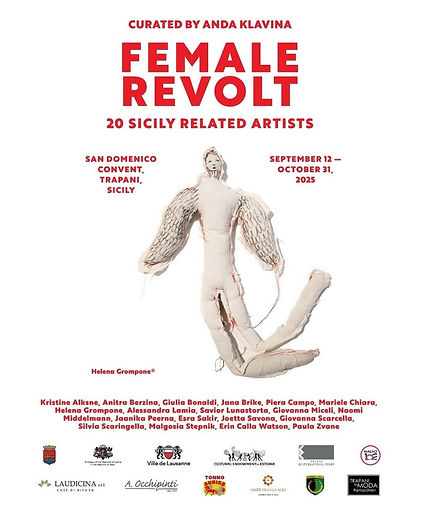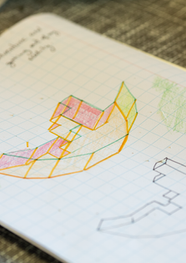



Exhibition of Esra Sakir
A. Cordici Museum, Erice, Sicily
The exhibition of artist Esra Sakir unfolds from the soil of Sicily and from the timeless figure of the Mother Goddess. During her research residency with the Municipality of Erice, Sakir explored the island’s terrain and collects local clay from its valleys. She processed and transformed these raw materials into ceramic works that speak of place, ancestry, and continuity.
This exhibition connects Sakir’s physical engagement with Sicilian soil to her broader artistic research on the Mother Goddess. An archetype that travels across civilizations from Anatolia to the Mediterranean.
Her works re-examine ancient representations of the divine feminine while opening space for contemporary dialogues on cultural memory, biodiversity, and the relationship between humans and the natural world.
About the Artist
Esra Sakir’s roots lie between Turkey and Italy, and her artistic path consistently bridges cultures. She begins her art studies at the age of 11 in the studios of professional artists, and at 18 moves to Milan to study at the Brera Academy of Fine Arts, graduating in 1996. Her early practice is shaped by magical realism.
In 2006, she returns to Istanbul to teach art at Yeditepe University, guiding students in re-reading art history. Two years later, she relocates to the Netherlands to pursue a Master of Fine Arts at the Hogeschool voor de Kunsten, Utrecht, where she develops a research-based practice intertwining visual art with theories of human rights, women’s empowerment, and intercultural dialogue.
Her work evolves across painting, silkscreen, digital media, and short films, and since 2019 she increasingly turns to ceramics as a medium to engage with cultural heritage and environmental concerns. Recent projects include a residency at AGA Lab (2023) and collaborative exhibitions in Amsterdam with Waag Futurelab and Voedselpark, where she leads workshops with wild clay from the Lutkemeerpolder, linking soil, food, and art.
Today, her practice weaves together historical references, ecological awareness, and collective memory—made tangible through clay, the material of the earth itself.
Workshop at the A. Cordici Museum on the
17th of September
13:00-15:30



“Research based artistic production delves me in social subjects with additional readings on antropologie, human non-human rights and new ethics. I am deeply passionate about clay, utilizing it as a medium to engage with others on pressing humanitarian and environmental issues. This gives me the opportunity to reflect and experience the basics of the elements such as earth, fire, air and water. At the forefront of these concerns is the environment and climate change, which necessitate new paradigms of living and consumption. My research delves into the transformative potential of forms and shapes in reshaping our daily consumption habits and priorities. Through hands-on experience, clay elevates intellectual understanding to a sensory level, offering a profound opportunity for introspection.
As an artist originating from Asia Minor, I draw inspiration from the historical heritage of the region, exploring the complex relationships between humans and the non-human world, imbuing them with a sense of sanctity through the amalgamation of various life forms.
The discovery of clay in Amsterdam's Lutkemeerpolder has been incredibly inspiring. Its proximity to home and pristine quality make it as valuable as gold. In the spring of 2024, I embark on a period of experimentation, harnessing the 'Gold of Amsterdam' to sculpt not just objects, but metaphors for our evolving ethics in food choices, consumption patterns, and social relations. These workshops serve as a platform for people to come together, exchange knowledge, and mutually enrich one another, laying the groundwork for a sustainable future.
My perspective has been shaped by my experiences of leaving home at 18 and living in Istanbul, Milan, and Amsterdam for extended periods. Through my workshops, I seek to cultivate dialogue, share knowledge, and foster connections that transcend geographical and cultural boundaries. I prioritize constructive and hopeful insights, providing a space for individuals to share personal narratives and explore common questions." - Esra Sakir
The Gold of Amsterdam
Trailer of the short documentary about the Lutkemeerpolder wild clay - 30 min
Creating a New Community: Intercultural Aspects of Creative Practice
In the city of Amsterdam, we have natural clay at the Lutkemeerpolder. During this artist residency program in April/May 2024, my focus was on discovering the social aspects of creative practice within the soil, creating dialogue, exchanging knowledge, and reflecting on healthier consumption models.
The Soil Through Our Hands: Connecting with Nature
One of the foundational steps in this process is the discovery and interaction with the soil itself, symbolising a return to our roots and the basics of existence. Air, water, fire, and earth have been considered fundamental elements since ancient times; ceramic is a process where these elements combine in proportional combinations to form a tangible result. By physically working with the natural Lutkemeer clay, participants feel the soil through their hands, listen to its needs, and align their priorities with the earth. The slow, tactile nature of working with this materia provides a reset, a return to basics, and a space for reflection on human soil relation. This process fosters a deeper connection with the core self, transcending individualistic, self-centred thinking.
Embracing Diversity: A Source of Enrichment
Diversity, whether cultural or biological, enriches our lives and communities. The challenge lies in balancing diverse cultural heritages with the broader, often dominant, Western paradigms. This balance requires sensitivity and openness to different perspectives and practices. In this context, clay workshops emerge as a powerful tool, erasing geographical boundaries, difference of age, ethnicity, education, and gender. This gives foreground to open up to the approach of a communal mindset, where the focus is on coming together, becoming one with the community, and appreciating the intrinsic value of diversity—both among people and within biodiversity. Through these workshops, a social engagement unfolds, allowing participants to explore possibilities for reconnection and dialogue.
Clay Objects: Reflections of Experience
The clay objects created in these workshops serve as tangible reflections of this journey. They encapsulate the experience and the findings, offering a sensorial understanding of the process. These objects become symbols of the interconnectedness of society and nature. Moreover, they inspire a heightened consciousness in food consumption, reminding participants of the importance of mindful eating and sustainable agricultural practices.







Catalogue MUD BREAK
01
Clay Collecting
02
Workshop
03
Wood Firing
A one-day visit to Boterbloem farm will allow participants to connect with the natural environment by spending time in the fields, collecting clay from the soil, and learning how to process it. This activity is deeply therapeutic, allowing participants to walk barefoot on the soil and work with their hands on the clay.
The workshop experience encourages participants to reflect on the basics of existence and the resources we often take for granted. Working with these elemental forces fosters an appreciation for nature’s gifts and underscores the simplicity of creation with what is readily available. This mindful sensorial engagement with earth, water, air, and fire nurtures an awareness of sustainable practices and gentle consumption.
Wood firing is a magical process that transforms your creations through the unpredictable dance of fire and natural elements. The flames and ash of the wood create unique textures and color variations that cannot be replicated in electric or gas kilns. For many ceramic artists, wood firing is the holy grail—yet the tradition is almost impossible to find in the Netherlands.
Sicily
During my visit to Sicily last summer, I had the opportunity to discover the region’s local clay and experiment with wood firing. This experience inspired me to create a series of sculptural works that showcase the beauty and unique qualities of this natural treasure. I am truly excited to return to Sicily, to work with its distinctive clay, and to immerse myself in its rich cultural and ceramic heritage. The historical ties between Sicily and the Middle East, the island’s profound iconographic traditions, and the legacy of Venere di Erice serve as key inspirations for my work. As an artist deeply passionate about historical traditions and environmental consciousness, I aim to explore how Sicilian wild clay can be integrated into contemporary artistic practice. With this initiative, I hope to contribute to the promotion of Erice within the broader ceramic tradition.
During the summer of 2025, I will create sculptures that blend local Sicilian clay with industrial clay, experimenting with textures and material qualities to bridge traditional and modern approaches. My work will incorporate historical iconography, drawing from Sicily’s deep artistic history while reinterpreting it in a contemporary context. Through this process, I hope to elevate and celebrate the region’s rich ceramic traditions. I would like to inspire locals and visitors, to refresh their memory on the soil and work the local wild clay.
Wood Firing
Wild clay harvested directly from the ground is an adventure to experience. It changes all we think about ourselves, our purposes in life and our connection with the rest. Knowing how to treat it and giving it form resets the mind and slows down time.
Working with the soil enhances the empathetic relation between human and nature. Wood firing in particular, is a magical process that transforms your creations through the unpredictable dance of fire and natural elements. The flames and ash of the wood create unique textures and color variations that cannot be replicated in electric or gas kilns. For many ceramic artists, wood firing is the holy grail— is an ancient practice that has been used across the world.
Many of today’s ceramicists yearn to experiment with this method, but due to its rarity and the resources required, few have had the chance to try. I experimented with the wild clay in Amsterdam at Lutkemeerpolder, in Sicily around Trapani, each geography offers its own characteristics. Sicily has preserved these methods in small local communities, making it one of the few places in Europe where this heritage remains strong.







